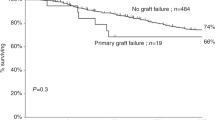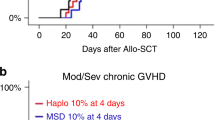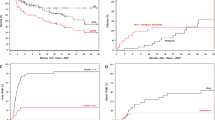Abstract
Children with Philadelphia chromosome positive (Ph+) acute lymphocytic leukemia (ALL) have only a 20% event-free survival when treated with chemotherapy alone. Bone marrow transplant (BMT) for patients with matched siblings has been associated with significantly better long-term survival. We asked whether children who lack a matched sibling donor would do as well if an alternative donor was utilized. Between 1987 and 2002, we transplanted 29 children and adolescents using either an unrelated donor (23) or a mismatched family member (six). The conditioning regimen included cytosine-arabinoside, cyclophosphamide and total body irradiation. Graft-versus-host disease (GVHD) prophylaxis consisted of T-cell depletion (antibody T10B9 or OKT3 and complement) with post transplant cyclosporine (CSA). All patients engrafted. Four developed grades III–IV acute GVHD. Three of 24 evaluable patients developed extensive chronic GVHD. Two patients died of relapse (7%). Two long-term survivors (>6 years) died of malignant glioblastoma multiforme. Event-free survival at 3, 5, and 10 years is 56, 51, and 46%, respectively. Five of six patients in >CR2 or relapse at the time of transplant died. Our data should encourage the use of alternative donor transplants early in the course of disease for children with Ph+ ALL.
This is a preview of subscription content, access via your institution
Access options
Subscribe to this journal
Receive 12 print issues and online access
$259.00 per year
only $21.58 per issue
Buy this article
- Purchase on Springer Link
- Instant access to full article PDF
Prices may be subject to local taxes which are calculated during checkout

Similar content being viewed by others
References
Crist W, Carroll A, Shuster J, Jackson J, Head D, Borowitz M et al. Philadelphia chromosome positive childhood acute lymphoblastic leukemia: clinical and cytogenetic characteristics and treatment outcome. A Pediatric Oncology Group study. Blood 1990; 76: 489–494.
Fletcher JA, Lynch EA, Kimball VM, Donnelly M, Tantravahi R, Sallan SE . Translocation (9;22) is associated with extremely poor prognosis in intensively treated children with acute lymphoblastic leukemia. Blood 1991; 77: 435–439.
Uckun FM, Nachman JB, Sather HN, Sensel MG, Kraft P, Steinherz PG et al. Clinical significance of Philadelphia chromosome positive pediatric acute lymphoblastic leukemia in the context of contemporary intensive therapies: a report from the Children's Cancer Group. Cancer 1998; 83: 2030–2039.
Arico M, Valsecchi MG, Camitta B, Schrappe M, Chessells J, Baruchel A et al. Outcome of treatment in children with Philadelphia chromosome-positive acute lymphoblastic leukemia. N Engl J Med 2000; 342: 998–1006.
Marks DI, Bird JM, Cornish JM, Goulden NJ, Jones CG, Knechtli CJ et al. Unrelated donor bone marrow transplantation for children and adolescents with Philadelphia-positive acute lymphoblastic leukemia. J Clin Oncol 1998; 16: 931–936.
Sierra J, Radich J, Hansen JA, Martin PJ, Petersdorf EW, Bjerke J et al. Marrow transplants from unrelated donors for treatment of Philadelphia chromosome-positive acute lymphoblastic leukemia. Blood 1997; 90: 1410–1414.
Bodmer JG, Marsh SG, Albert ED, Bodmer WF, Bontrop RE, Dupont B et al. Nomenclature for factors of the HLA system, 1998. Eur J Immunogenet 1999; 26: 81–116.
Baxter-Lowe LA, Keever C, Dinauer D, Daniels T, Johnson K, Camitta B et al. Use of solid phase automated sequencing to define HLA disparity between bone marrow donors and recipients. Transplant Proc 1995; 27: 1377–1378.
Ash RC, Casper JT, Chitambar CR, Hansen R, Bunin N, Truitt RL et al. Successful allogeneic transplantation of T-cell-depleted bone marrow from closely HLA-matched unrelated donors. N Engl J Med 1990; 322: 485–494.
Drobyski WR, Ash RC, Casper JT, McAuliffe T, Horowitz MM, Lawton C et al. Effect of T-cell depletion as graft-versus-host disease prophylaxis on engraftment, relapse, and disease-free survival in unrelated marrow transplantation for chronic myelogenous leukemia. Blood 1994; 83: 1980–1987.
Lawton CA, Cohen EP, Murray KJ, Derus SW, Casper JT, Drobyski WR et al. Long-term results of selective renal shielding in patients undergoing total body irradiation in preparation for bone marrow transplantation. Bone Marrow Transplant 1997; 20: 1069–1074.
Keever-Taylor CA, Craig A, Molter M, Fu P, Loebel A, Skonecki J et al. Complement-mediated T-cell depletion of bone marrow: comparison of T10B9.1A-31 and Muromonab-Orthoclone OKT3. Cytotherapy 2001; 3: 467–481.
Waid TH, Lucas BA, Amlot P, Janossy G, Yacoub M, Cammisuli S et al. T10B9.1A-31 anti-T-cell monoclonal antibody: preclinical studies and clinical treatment of solid organ allograft rejection. Am J Kidney Dis 1989; 14 (5 Suppl 2): 61–70.
Marks DI, Bird JM, Vettenranta K, Hunt L, Green A, Cornish JM et al. T cell-depleted unrelated donor bone marrow transplantation for acute myeloid leukemia. Biol Blood Marrow Transplant 2000; 6: 646–653.
Drobyski WR, Klein J, Flomenberg N, Pietryga D, Vesole DH, Margolis DA et al. Superior survival associated with transplantation of matched unrelated versus one-antigen-mismatched unrelated or highly human leukocyte antigen-disparate haploidentical family donor marrow grafts for the treatment of hematologic malignancies: establishing a treatment algorithm for recipients of alternative donor grafts. Blood 2002; 99: 806–814.
Glucksberg H, Storb R, Fefer A, Buckner CD, Neiman PE, Clift RA et al. Clinical manifestations of graft-versus-host disease in human recipients of marrow from HLA-matched sibling donors. Transplantation 1974; 18: 295–304.
Shulman HM, Sullivan KM, Weiden PL, McDonald GB, Striker GE, Sale GE et al. Chronic graft-versus-host syndrome in man. A long-term clinicopathologic study of 20 Seattle patients. Am J Med 1980; 69: 204–217.
Kaplan EL, Meier P . Nonparametric estimation from incomplete observations. J Am Stat Assoc 1958; 53: 457–481.
Casper J, Camitta B, Truitt R, Baxter-Lowe LA, Bunin N, Lawton C et al. Unrelated bone marrow donor transplants for children with leukemia or myelodysplasia. Blood 1995; 85: 2354–2363.
Walter AW, Hancock ML, Pui CH, Hudson MM, Ochs JS, Rivera GK et al. Secondary brain tumors in children treated for acute lymphoblastic leukemia at St Jude Children's Research Hospital. J Clin Oncol 1998; 16: 3761–3767.
Relling MV, Rubnitz JE, Rivera GK, Boyett JM, Hancock ML, Felix CA et al. High incidence of secondary brain tumours after radiotherapy and antimetabolites. Lancet 1999; 354: 34–39.
Belkacemi Y, Labopin M, Vernant JP, Prentice HG, Tichelli A, Schattenberg A et al. Cataracts after total body irradiation and bone marrow transplantation in patients with acute leukemia in complete remission: a study of the European Group for Blood and Marrow Transplantation. Int J Radiat Oncol Biol Phys 1998; 41: 659–668.
Socie G, Curtis RE, Deeg HJ, Sobocinski KA, Filipovich AH, Travis LB et al. New malignant diseases after allogeneic marrow transplantation for childhood acute leukemia. J Clin Oncol 2000; 18: 348–357.
Scheuring UJ, Pfeifer H, Wassmann B, Bruck P, Gehrke B, Petershofen EK et al. Serial minimal residual disease (MRD) analysis as a predictor of response duration in Philadelphia-positive acute lymphoblastic leukemia (Ph+ALL) during imatinib treatment. Leukemia 2003; 17: 1700–1706.
Cazzaniga G, Lanciotti M, Rossi V, Di Martino D, Arico M, Valsecchi MG et al. Prospective molecular monitoring of BCR/ABL transcript in children with Ph+ acute lymphoblastic leukaemia unravels differences in treatment response. Br J Haematol 2002; 119: 445–453.
Lee S, Kim DW, Kim YJ, Chung NG, Kim YL, Hwang JY et al. Minimal residual disease-based role of imatinib as a first-line interim therapy prior to allogeneic stem cell transplantation in Philadelphia chromosome-positive acute lymphoblastic leukemia. Blood 2003; 102: 3068–3070.
Acknowledgements
We thank Dan Eastwood, MS and Christian Boudreau, Ph.D., for their statistical assistance with this manuscript. This study was supported in part by the Midwest Athletes Against Childhood Cancer (MACC Fund).
Author information
Authors and Affiliations
Corresponding author
Rights and permissions
About this article
Cite this article
Talano, J., Casper, J., Camitta, B. et al. Alternative donor bone marrow transplant for children with Philadelphia chromosome ALL. Bone Marrow Transplant 37, 135–141 (2006). https://doi.org/10.1038/sj.bmt.1705200
Received:
Revised:
Accepted:
Published:
Issue Date:
DOI: https://doi.org/10.1038/sj.bmt.1705200
Keywords
This article is cited by
-
Allogeneic transplantation for childhood ALL
Bone Marrow Transplantation (2008)
-
Unrelated donor allogeneic transplantation for adult acute lymphoblastic leukemia: a review
Bone Marrow Transplantation (2008)



